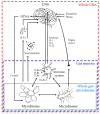The Mycobiome: A Neglected Component in the Microbiota-Gut-Brain Axis
- PMID: 29522426
- PMCID: PMC5874636
- DOI: 10.3390/microorganisms6010022
The Mycobiome: A Neglected Component in the Microbiota-Gut-Brain Axis
Abstract
In recent years, the gut microbiota has been considered as a full-fledged actor of the gut-brain axis, making it possible to take a new step in understanding the pathophysiology of both neurological and psychiatric diseases. However, most of the studies have been devoted to gut bacterial microbiota, forgetting the non-negligible fungal flora. In this review, we expose how the role of the fungal component in the microbiota-gut-brain axis is legitimate, through its interactions with both the host, especially with the immune system, and the gut bacteria. We also discuss published data that already attest to a role of the mycobiome in the microbiota-gut-brain axis, and the impact of fungi on clinical and therapeutic research.
Keywords: brain–gut axis; dysbiosis; fungus; microbiome; mycobiome; neurological disorders; psychiatric disorders.
Conflict of interest statement
The authors declare that they have no conflict of interest.
Figures

References
-
- Kennedy P.J., Murphy A.B., Cryan J.F., Ross P.R., Dinan T.G., Stanton C. Microbiome in brain function and mental health. Trends Food Sci. Technol. 2016;57:289–301. doi: 10.1016/j.tifs.2016.05.001. - DOI
-
- O’Mahony S.M., Marchesi J.R., Scully P., Codling C., Ceolho A.-M., Quigley E.M.M., Cryan J.F., Dinan T.G. Early life stress alters behavior, immunity, and microbiota in rats: Implications for irritable bowel syndrome and psychiatric illnesses. Biol. Psychiatry. 2009;65:263–267. doi: 10.1016/j.biopsych.2008.06.026. - DOI - PubMed
Publication types
LinkOut - more resources
Full Text Sources
Other Literature Sources

